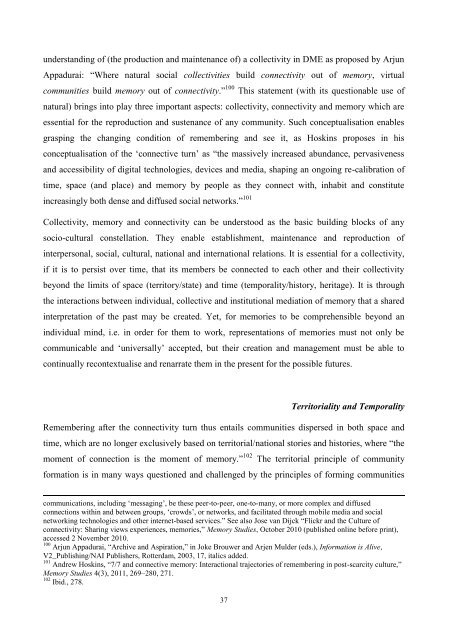UNIVERSITY OF NOVA GORICA GRADUATE SCHOOL ...
UNIVERSITY OF NOVA GORICA GRADUATE SCHOOL ...
UNIVERSITY OF NOVA GORICA GRADUATE SCHOOL ...
Create successful ePaper yourself
Turn your PDF publications into a flip-book with our unique Google optimized e-Paper software.
understanding of (the production and maintenance of) a collectivity in DME as proposed by Arjun<br />
Appadurai: ―Where natural social collectivities build connectivity out of memory, virtual<br />
communities build memory out of connectivity.‖ 100 This statement (with its questionable use of<br />
natural) brings into play three important aspects: collectivity, connectivity and memory which are<br />
essential for the reproduction and sustenance of any community. Such conceptualisation enables<br />
grasping the changing condition of remembering and see it, as Hoskins proposes in his<br />
conceptualisation of the ‗connective turn‘ as ―the massively increased abundance, pervasiveness<br />
and accessibility of digital technologies, devices and media, shaping an ongoing re-calibration of<br />
time, space (and place) and memory by people as they connect with, inhabit and constitute<br />
increasingly both dense and diffused social networks.‖ 101<br />
Collectivity, memory and connectivity can be understood as the basic building blocks of any<br />
socio-cultural constellation. They enable establishment, maintenance and reproduction of<br />
interpersonal, social, cultural, national and international relations. It is essential for a collectivity,<br />
if it is to persist over time, that its members be connected to each other and their collectivity<br />
beyond the limits of space (territory/state) and time (temporality/history, heritage). It is through<br />
the interactions between individual, collective and institutional mediation of memory that a shared<br />
interpretation of the past may be created. Yet, for memories to be comprehensible beyond an<br />
individual mind, i.e. in order for them to work, representations of memories must not only be<br />
communicable and ‗universally‘ accepted, but their creation and management must be able to<br />
continually recontextualise and renarrate them in the present for the possible futures.<br />
Territoriality and Temporality<br />
Remembering after the connectivity turn thus entails communities dispersed in both space and<br />
time, which are no longer exclusively based on territorial/national stories and histories, where ―the<br />
moment of connection is the moment of memory.‖ 102 The territorial principle of community<br />
formation is in many ways questioned and challenged by the principles of forming communities<br />
communications, including ‗messaging‘, be these peer-to-peer, one-to-many, or more complex and diffused<br />
connections within and between groups, ‗crowds‘, or networks, and facilitated through mobile media and social<br />
networking technologies and other internet-based services.‖ See also Jose van Dijck ―Flickr and the Culture of<br />
connectivity: Sharing views experiences, memories,‖ Memory Studies, October 2010 (published online before print),<br />
accessed 2 November 2010.<br />
100 Arjun Appadurai, ―Archive and Aspiration,‖ in Joke Brouwer and Arjen Mulder (eds.), Information is Alive,<br />
V2_Publishing/NAI Publishers, Rotterdam, 2003, 17, italics added.<br />
101 Andrew Hoskins, ―7/7 and connective memory: Interactional trajectories of remembering in post-scarcity culture,‖<br />
Memory Studies 4(3), 2011, 269–280, 271.<br />
102 Ibid., 278.<br />
37

















